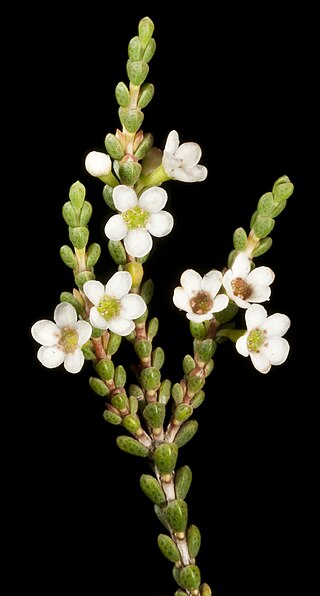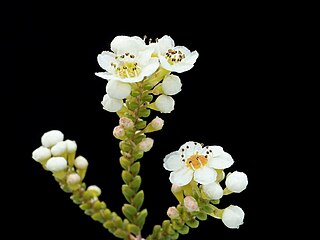
Thryptomene hexandra, commonly known as Palm Valley myrtle in the Northern Territory, is a species of flowering plant in the family Myrtaceae and is endemic to north-eastern Australia. It is an erect, much-branched shrub with linear to lance-shaped leaves and white flowers with six stamens.
Micromyrtus barbata is a species of flowering plant in the family Myrtaceae and is endemic to inland areas of Western Australia. It is a shrub with small, overlapping, narrowly egg-shaped leaves and small white flowers arranged singly in upper leaf axils.
Micromyrtus chrysodema is a species of flowering plant in the myrtle family, Myrtaceae and is endemic to a small area of inland Western Australia. It is a densely branched shrub with small, narrowly oblong leaves and small white flowers.

Micromyrtus erichsenii is a species of the family Myrtaceae and is endemic to Western Australia. It is an erect shrub with small, egg-shaped leaves with the narrower end towards the base, and white or cream-coloured flowers 3–4 mm (0.12–0.16 in) in diameter and 5 to 10 stamens.
Micromyrtus fimbrisepala is a species of flowering plant in the family Myrtaceae and is endemic to inland Australia. It is a shrub with overlapping, broadly elliptic to more or less round leaves and small pink flowers arranged singly in upper leaf axils.

Micromyrtus flaviflora is a species of flowering plant in the myrtle family, Myrtaceae and is endemic to inland areas of Australia. It is an erect shrub with overlapping, keeled, oblong leaves, and yellow flowers arranged singly in leaf axils, but often appearing clustered.
Micromyrtus greeniana is a species of flowering plant in the myrtle family, Myrtaceae and is endemic to a small area in the west of Western Australia. It is a spindly shrub with linear to egg-shaped leaves and small white or cream-coloured flowers.
Micromyrtus helmsii is a species of flowering plant in the myrtle family, Myrtaceae and is endemic to inland areas of Australia. It is a slender, erect or spreading shrub with overlapping, decussate, oblong leaves, and flowers with about 7 stamens, arranged singly in leaf axils.
Micromyrtus hymenonema is a species of flowering plant in the myrtle family, Myrtaceae and is endemic to inland areas of Western Australia. It is a shrub with overlapping, decussate linear leaves and pink flowers arranged singly in leaf axils with about 10 stamens in each flower.
Micromyrtus navicularis is a species of flowering plant in the myrtle family, Myrtaceae and is endemic to a small area in the south of Western Australia. It is an erect shrub with narrowly egg-shaped leaves, and small white flowers in upper leaf axils with 10 stamens in each flower.
Micromyrtus obovata is a species of the flowering plant in the family Myrtaceae and is endemic to the south-west of Western Australia. It is an erect shrub with egg-shaped leaves with the narrower end toward the base, white flowers 4–5 mm (0.16–0.20 in) in diameter, and 10 stamens in each flower.
Micromyrtus prochytes is species of the flowering plant in the family Myrtaceae and is endemic to inland areas of Western Australia. It is an erect shrub with narrowly egg-shaped leaves with the narrower end toward the base, and white or pink flowers 3.0–4.0 mm (0.12–0.16 in) in diameter.

Micromyrtus racemosa is species of the flowering plant in the family Myrtaceae and is endemic to the south-west of Western Australia. It is a shrub with relatively thick, narrowly egg-shaped leaves, sometimes with the narrower end toward the base, and white, cream-coloured or yellow flowers 2.5–4.0 mm (0.098–0.157 in) in diameter.

Micromyrtus redita is species of the flowering plant in the family Myrtaceae and is endemic to the south-west of Western Australia. It is a densely branched shrub with narrowly oblong to elliptic leaves, reddish sepals and white or pink petals.

Micromyrtus sulphurea is a species of flowering plant in the family Myrtaceae and is endemic to the inland of Western Australia. It is a commonly stunted or widely spreading shrub with narrowly oblong leaves pressed against the stem, and yellow flowers with 10 stamens.
Thryptomene elliottii is a species of flowering plant in the family Myrtaceae and is endemic to southern central Australia. It is a shrub with decussate, egg-shaped to club-shaped leaves and pink or white flowers with five petals and five stamens.
Thryptomene naviculata is a species of flowering plant in the family Myrtaceae and is endemic to central areas of Western Australia. It is a rounded shrub with overlapping, decussate, egg-shaped leaves with the narrower end towards the base and white flowers with five petals and five stamens.
Thryptomene nealensis is a species of flowering plant in the family Myrtaceae and is endemic to central areas of Western Australia. It is a shrub with overlapping, decussate, linear leaves and pink flowers with five petals and usually five stamens.

Thryptomene parviflora is a species of flowering plant in the family Myrtaceae and is endemic to Queensland. It is a slender, erect shrub with decussate, linear to egg-shaped leaves with the narrower end towards the base, and flowers with five petals and five stamens arranged singly in leaf axils.

Micromyrtus hexamera is a species of flowering plant in the myrtle family, Myrtaceae and is endemic to eastern Australia. It is a shrub with many drooping branches, egg-shaped leaves with the narrower end towards the base, and white to pink flowers arranged singly in leaf axils with 12 stamens in each flower.







